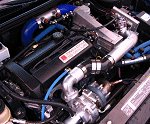

|
Street Class Unlimited Class
DOHC SOHC Ion Updated 1/05 For the most recent list of the fastest five cars click here. |
Ian's Turbo F.A.Q. - Page 2by:Qksl2The manifold: What style should I get? What kind of flange? A turbo manifold is just like your stock exhaust manifold except for that it directs air into the turbo to drive the exhaust wheel instead of leading straight out to the exhaust system. After going through the turbo, the down-pipe is what connects the turbo to the rest of the exhaust. The design of this is critical. There are log, cast, and tubular style turbo manifolds. Tubular equal length manifolds make the most horsepower with longer runners and an equal length design. They are designed such that exhaust pulses do not interfere with each other. Faster spool up and strong top end power are characteristic of this style.However, they are typically more expensive and require more bracing to prevent any cracking. They also take up more space and are more difficult to design. Twistec has popularized the use of a stock cast exhaust manifold that has the bottom chopped off and a flange welded on. This design is efficient in packaging. The cast manifold is very strong, and although tedious, when properly welded, the flange mounting is good as well. This puts the turbo down low, which is generally a good thing. The main drawbacks for this manifold is that horsepower is limited by the extremely small stock runners. It is hard to plumb an efficient down-pipe with this setup as well. It is also not equal length. However, it is cheap to build, and effective for a low boost setup. Log style manifolds come in many variations. They are available now from Turbosaturns.net. In the past, Thomas Knight has had a design, but I believe is no longer making them. This has been used to make great power on a Saturn, despite its design. The benefits are that they are relatively cheap and simple, as well as strong. Update 10/03: A new Turbosaturns.net log style is now available. This will end all your quests for a manifold to turbo your DOHC. It is a simple, extremely strong log style manifold available with any flange for your specific turbo. Cost is only $225, and it is typically shipped just a few weeks from your time of order. This is the answer we have been waiting for: impeccable quality, strength, and at a cost Honda owners will be jealous of! Email me @ webmaster@qksltwo.com to order. This is the end to your quest for a manifold! As far as making your own, you'll have to work with a shop that does TIG welding. Stainless Steel is the best way to go, and you can then have it ceramic coated. It is not necessary but nice for looks and heat control. The best flange for most applications will be a standard T3 flange as it allows you a variety of options. Doesn't the turbo increase exhaust backpressure? Under boost conditions, no. Here's why: When the exhaust valve opens, the pressure inside the cylinder is much much higher than the pressure at the turbo inlet. That cylinder pressure "blows down" very quickly, but we're on the exhaust stroke. The cylinder volume is decreasing very rapidly, and from the Ideal Gas Law, that tends to keep the cylinder pressure higher than the turbo inlet pressure. Finally, when the exhaust stroke is nearly done, and the pressures are nearly equal, the intake valve opens, the intake pressure (we're under boost here!) "blows down" into the cylinder, and presto! We have a higher cylinder pressure once again. Cylinder pressure make torque, torque at RPM (where the right sized turbo gets jiggy wid it) makes power. Power makes speed. Yay! Where do I tap my manifold for an EGT gauge? The best place is the number 3 cylinder runner on the manifold. If you are looking straight on at your engine bay, moving from left to the right, it's the third runner. The probe should be placed 1-2" from the flange where the manifold/header meets the head. Typical EGT (in Fahrenheit) readings at 7 PSI on a DOHC w/ the SDS EIC. Idle............................................750 The readings will vary based on gearing, mph, and outside temperature,
as well as your a/f mixture. You do not want to exceed How do I add fuel to my turbo system? This is the most controversial issue out there, right now. There are several methods that work, some proven, some not. For Saturns, you can do a few things: Larger injectors with an rising rate fuel pressure regulator (RRFPR), an AFC or AFR with larger fuel injectors, extra injectors and a control unit, or a full stand alone fuel system. A simple and effective way to add fuel for low boost would be to
use larger injectors, such as 35# injectors, along with a RRFPR.
You'll need "Bosch" style injectors: commonly available
as Ford or Mopar injectors. Check out www.fwdperformance.com
for injectors. 35# injectors are good for a descent increase in
power along with a fuel pressure regulator that is either 1:1, 2:1,
or maximum 3:1. This setup will be safe, consistent, and easy. It
should be tuned on the dyno by Something not absolutely proven with Saturns, but commonly used among turbo Honda owners is a simple AFC or AFR with larger injectors. The AFC is a fuel computer by Apex, and the AFR is the same thing by HKS. Both modify the map signal to the computer so that you can adjust the injector pulse width at certain RPM points. I will be experimenting with this in the future and will determine how well it works. This is a step up from using a fuel pressure regulator as it is more precise. Update: Don't bother with this, the Greddy E-Manage, HKS AFR, or any other "piggy back" fuel controller.They are terribly flawed in that despite their ability to trick the computer into modifying injector pulse width, they cannot change the "closed loop" operation of the Saturn PCM. Basically, at any time part throttle less than 70%, the computer is striving for a 14.7:1, or "stoich", air fuel ratio. Combine this with boost, and it provides for a very lean condition! It only gets worse though. Modifying the MAP (pressure in the intake manifold) signal to the PCM to trick it into thinking there is more vacuum than their really is causes the PCM to advance the timing. We've seen upwards of 50degrees forward through the midrange by using something like an AFC. This is VERY bad for boost! Considering the cost and the lack of ability of this type of setup, I highly recommend against it! The most successful way of adding fuel to turbo Saturns thus far
has been the SDS EIC. That is: The Simple Digital Systems extra
injector controller (www.sdsefi.com).
I have used it, Chris used it, Alex, Tom, Paul, and Eric have all
used it. While highly scrutinized by many never-had-a-turbo people,
it has simply been reliable. Again, it is somewhat crude but works.
A huge benefit of this system is that it is completely separate
from your stock system. Think of it this way: your entire stock
fuel system goes on doing its job as it normally does. It idles
just the same, runs just the same while not under boost, and adjusts
the a/f ratio for maximum economy when cruising. The SDS is a system
that runs another fuel feed line to two extra injectors in your
intake piping (you can also get four extra injectors, one in each
intake manifold runner). You weld two injector bosses onto your
intake piping before the throttle body, much like a wet nitrous
system. The two extra injectors are controlled by the SDS, which
is boost and rpm referenced. This means that it sees both boost
and RPM and adds fuel accordingly. You adjust it via two knobs.
One to tell it when to come on (how much boost before it starts
squirting), and the other is how much to inject. When your engine
goes into boost, it starts to add fuel. It is very easy to get it
tuned on the street, and then it can be fine tuned on the dyno.
It is not too precise because you cannot adjust it at many RPM points.
However, the benefits are that there is no extra strain on your
stock fuel system, and the car drives just like normal when you
are not in boost. Skip to page 3, 4 |
|




